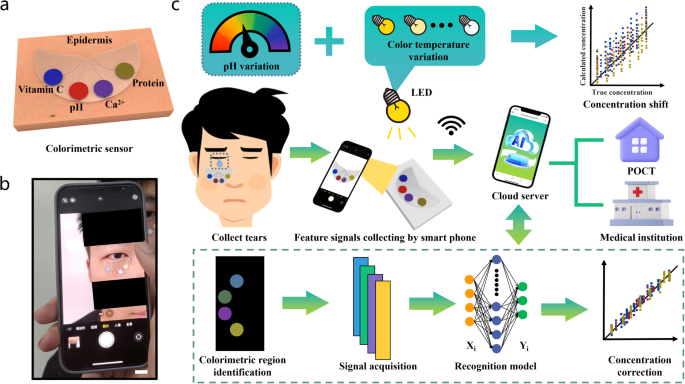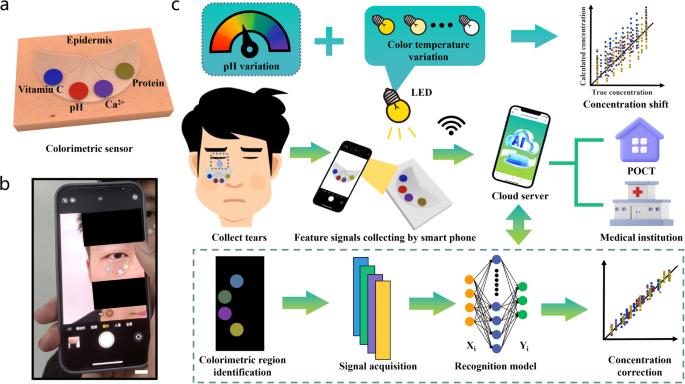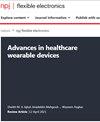An artificial intelligence-assisted microfluidic colorimetric wearable sensor system for monitoring of key tear biomarkers
IF 12.3
1区 材料科学
Q1 ENGINEERING, ELECTRICAL & ELECTRONIC
引用次数: 0
Abstract
The precise, simultaneous, and rapid detection of essential biomarkers in human tears is imperative for monitoring both ocular and systemic health. The utilization of a wearable colorimetric biochemical sensor exhibits potential in achieving swift and concurrent detection of pivotal biomarkers in tears. Nevertheless, challenges arise in the collection, interpretation, and sharing of data from the colorimetric sensor, thereby restricting the practical implementation of this technology. To overcome these challenges, this research introduces an artificial intelligence-assisted wearable microfluidic colorimetric sensor system (AI-WMCS) for rapid, non-invasive, and simultaneous detection of key biomarkers in human tears, including vitamin C, H+(pH), Ca2+, and proteins. The sensor consists of a flexible microfluidic epidermal patch that collects tears and facilitates the colorimetric reaction, and a deep-learning neural network-based cloud server data analysis system (CSDAS) embedded in a smartphone enabling color data acquisition, interpretation, auto-correction, and display. To enhance accuracy, a well-trained multichannel convolutional recurrent neural network (CNN-GRU) corrects errors in the interpreted concentration data caused by varying pH and color temperature in different measurements. The test set determination coefficients (R2) of 1D-CNN-GRU for predicting pH and 3D-CNN-GRU for predicting the other three biomarkers were as high as 0.998 and 0.994, respectively. This correction significantly improves the accuracy of the predicted concentration, enabling accurate, simultaneous, and quick detection of four critical tear biomarkers using only minute amounts of tears ( ~ 20 μL). This research demonstrates the powerful integration of a flexible microfluidic colorimetric biosensor and deep-learning algorithm, which holds immense potential to revolutionize the fields of health monitoring.


用于监测关键泪液生物标志物的人工智能辅助微流控比色可穿戴传感器系统
精确、同步、快速地检测人体泪液中的重要生物标志物对于监测眼部和全身健康状况至关重要。利用可穿戴比色生化传感器可实现对泪液中关键生物标志物的快速、同步检测。然而,在比色传感器的数据收集、解释和共享方面存在挑战,从而限制了这项技术的实际应用。为了克服这些挑战,本研究引入了一种人工智能辅助可穿戴微流控比色传感器系统(AI-WMCS),用于快速、无创、同步检测人类泪液中的关键生物标志物,包括维生素 C、H+(pH 值)、Ca2+ 和蛋白质。该传感器由一个柔性微流控表皮贴片和一个基于深度学习神经网络的云服务器数据分析系统(CSDAS)组成,前者用于收集泪液并促进比色反应,后者嵌入智能手机,可实现颜色数据的采集、解释、自动校正和显示。为提高准确性,一个训练有素的多通道卷积递归神经网络(CNN-GRU)可纠正不同测量中因 pH 值和色温变化而导致的浓度数据解释误差。预测 pH 值的 1D-CNN-GRU 和预测其他三种生物标记物的 3D-CNN-GRU 的测试集判定系数 (R2) 分别高达 0.998 和 0.994。这种校正大大提高了预测浓度的准确性,只需使用微量的泪液(约 20 μL)就能准确、同时、快速地检测出四种关键的泪液生物标记物。这项研究展示了灵活的微流控比色生物传感器与深度学习算法的有力结合,为健康监测领域带来了巨大的变革潜力。
本文章由计算机程序翻译,如有差异,请以英文原文为准。
求助全文
约1分钟内获得全文
求助全文
来源期刊

npj Flexible Electronics
Multiple-
CiteScore
17.10
自引率
4.80%
发文量
91
审稿时长
6 weeks
期刊介绍:
npj Flexible Electronics is an online-only and open access journal, which publishes high-quality papers related to flexible electronic systems, including plastic electronics and emerging materials, new device design and fabrication technologies, and applications.
文献相关原料
公司名称
产品信息
阿拉丁
o-cresolphthalein complexone
阿拉丁
8-hydroxyquinoline
阿拉丁
citric acid
阿拉丁
TBPB
阿拉丁
methyl red
阿拉丁
phenolphthalein
阿拉丁
bromothymol blue (BTB)
 求助内容:
求助内容: 应助结果提醒方式:
应助结果提醒方式:


